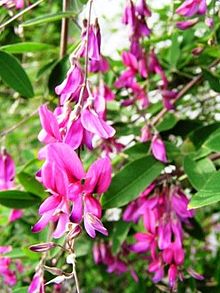| Lespedeza thunbergii | |
|---|---|

| |
| Scientific classification | |
| Kingdom: | Plantae |
| Clade: | Tracheophytes |
| Clade: | Angiosperms |
| Clade: | Eudicots |
| Clade: | Rosids |
| Order: | Fabales |
| Family: | Fabaceae |
| Subfamily: | Faboideae |
| Genus: | Lespedeza |
| Species: | L. thunbergii
|
| Binomial name | |
| Lespedeza thunbergii (DC.) Nakai (1927)
| |
| Subspecies[1] | |
|
5; see text | |
| Synonyms[1] | |
| |
Lespedeza thunbergii is a species of flowering plant in the legume family known by the common names Thunberg's bushclover, Thunberg's lespedeza, and shrub lespedeza. It is native to the eastern Himalayas, China, Korea, and Japan.[2]
This species produces annual stems up to 2 m (7 ft) tall and 0.5 in (1.3 cm) in diameter. They die back completely at the end of the season. The abundant pink to purplish flowers bloom in late summer. The fruit is a legume pod containing black seeds.[3]
Five subspecies are accepted:[1]
- Lespedeza thunbergii subsp. elliptica (Benth. ex Maxim.) H.Ohashi – eastern Himalayas to central China
- Lespedeza thunbergii subsp. formosa (Vogel) H.Ohashi – southeastern China, Taiwan, Korea, and Japan
- Lespedeza thunbergii subsp. patens (Nakai) H.Ohashi – Japan (northern and central Honshu)
- Lespedeza thunbergii subsp. satsumensis (Nakai) H.Ohashi – Japan (Kagoshima Prefecture)
- Lespedeza thunbergii subsp. thunbergii – central and southern China, Korea, central and southern Japan, and the Ryukyu Islands
The specific epithet thunbergii refers to the 18th-century Swedish botanist Carl Peter Thunberg.[4]
In cultivation this plant has gained the Royal Horticultural Society's Award of Garden Merit.[5][6] Cultivars include 'VA-70', 'Amquail',[3] 'White Fountain', and 'Gibraltar'.[7] This species has the capacity to become invasive.[3]
- ^ a b c Lespedeza thunbergii (DC.) Nakai. Plants of the World Online. Retrieved 4 September 2023.
- ^ "Lespedeza thunbergii". Germplasm Resources Information Network. Agricultural Research Service, United States Department of Agriculture. Retrieved 21 January 2018.
- ^ a b c Lespedeza thunbergii. USDA NRCS Plant Fact Sheet.
- ^ Harrison, Lorraine (2012). RHS Latin for gardeners. United Kingdom: Mitchell Beazley. p. 224. ISBN 9781845337315.
- ^ "RHS Plant Selector - Lespedeza thunbergii". Retrieved 3 October 2020.
- ^ "AGM Plants - Ornamental" (PDF). Royal Horticultural Society. July 2017. p. 59. Retrieved 21 March 2018.
- ^ Lespedeza thunbergii. Missouri Botanical Garden.